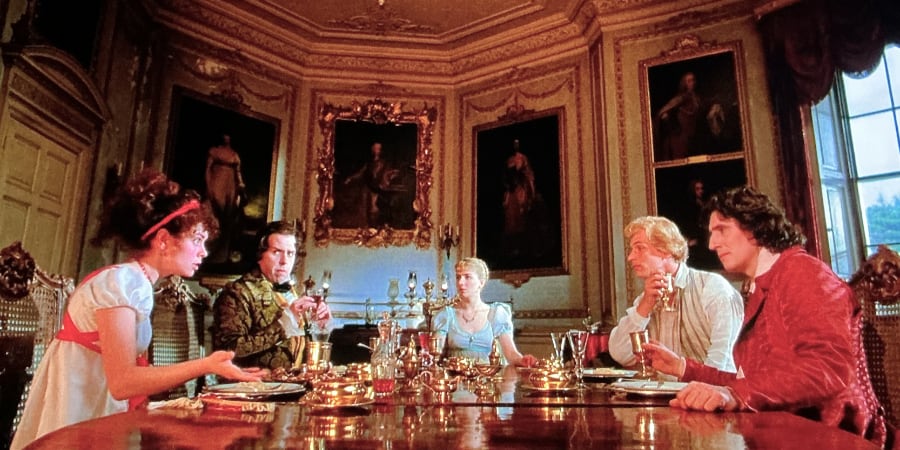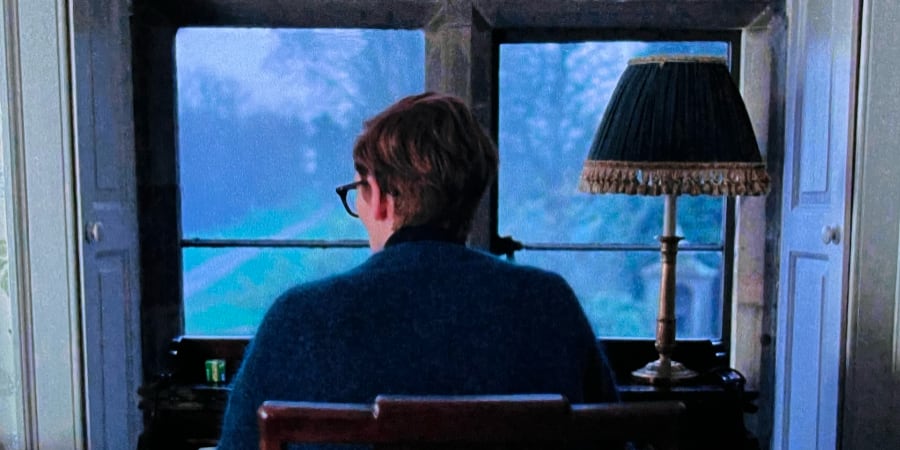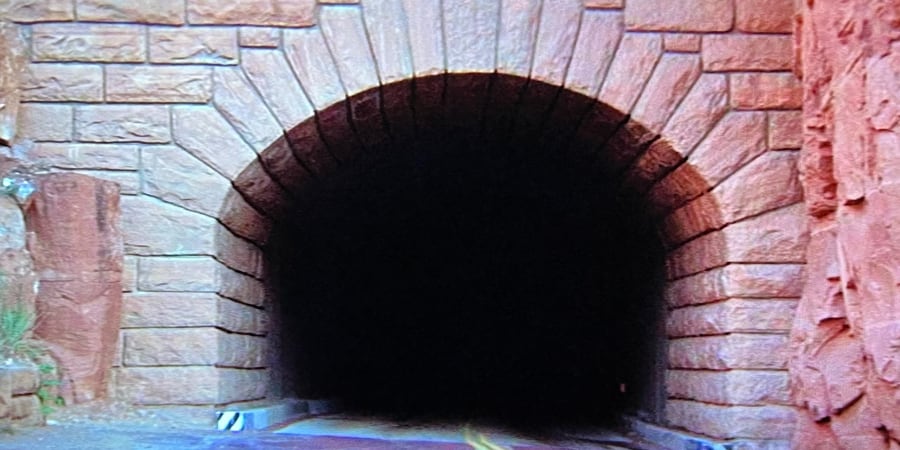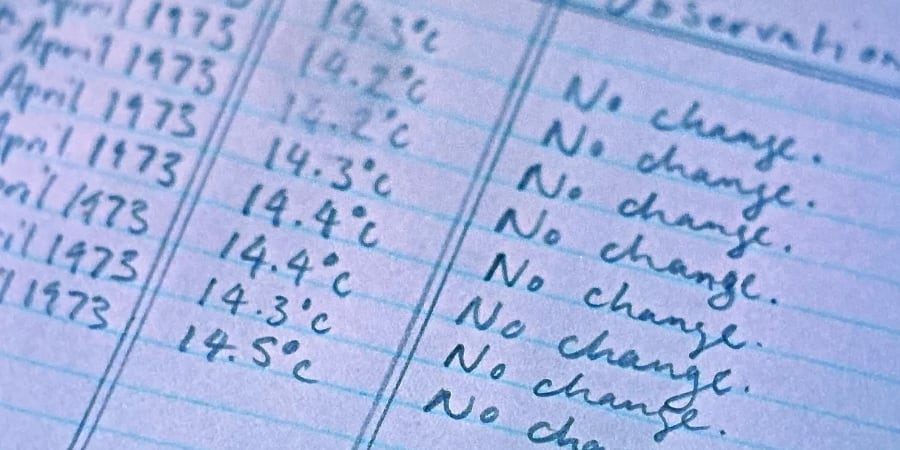Michael Walters
Notes from the peninsula
Welcome!
This is my little word garden on the internet—Michael Walters, author (it’s true!). I have a speculative fiction novel, THE COMPLEX, out with Salt Publishing, and I’m deep in the writing of a follow-up. I would love it if you gave it a try.
I use Bluesky to connect with people, Letterboxd to track films, and StoryGraph to track books. Follow me and say hello in all those places.
And if you want more of my thoughts on writing in particular, you can subscribe to my posts on PATREON. There’s a Weird and Wonderful tier if you want to support me with a donation, and that now includes notes on the novels I’m reading, but I post regularly to all patrons.

The Phantom of the Opera
Director: Dario Argento
Release year: 1998
After Hammer’s Dracula and Ken Russell’s Frankenstein origin story, The Phantom of the Opera was an accidentally perfect pick—another turn of the century literary adaptation, another Universal Monster, and the next film in my parallel project to watch all the films of Dario Argento in chronological order.
Looking for films for #31DaysofBlackXmas, it seemed wrong not to continue the Dario Argento quest I started back in June. That stalled because the films got harder to find, and frankly I was getting bored. Argento’s The Phantom of the Opera is only available on a DVD rip of what looks like a VHS (the quality is awful, which colours everything), but it wasn’t expensive, and I didn’t want to let go of the idea without another try.
A baby is put in a basket and released into the sewer. A rat spots it, pulls it to safety, and the rats raise the child as one of their own. This makes Argento’s Phantom the king of the rats when the story starts, but also a hunky blonde stud, played by Julian Sands as beautiful, charming, and with no mask in sight. The Christine he is entranced by is (of course) Argento’s daughter, Asia, caught between the good Baron, who woos her in conventional ways, and the dark Phantom, who can talk to her telepathically, kills people, and wants to keep her forever in his dank rat cave.
It took me a while to accept that Argento has made here a baroque mix of horror, romance and comedy, with some steampunk thrown in, and it was only the extended sequence of the rat-catcher careening through the caverns in a self-built rat vacuum-mincer where that hit home. If you’re looking for a straight horror, or a classic adaptation of the original novel, you’ll be disappointed, but if you’re able to look at this with an open mind (and find a copy of high enough quality to do the sets and costumes justice), then… you might think it works.
Looking back to his 1987 film Opera, the Phantom has always been in the back of Argento’s mind, and I wonder if it was a childhood favourite. He certainly loves theatrical spaces (like the opening of Deep Red). He’s made a long career from mysterious killers stalking artists. I wonder if there’s an interview where he talks about this? (Much scouring of the internet ensued, no evidence was found by the time this went to press.)

Gothic
Director: Ken Russell
Release year: 1986
Keeping things in the same vein (!), Gothic begins with famous poet Percy Shelley arriving at Villa Diodati on Lake Geneva to visit Lord Byron, with his bride-to-be Mary Godwin, and her stepsister Claire Clairmont. Byron’s physician Dr. John Polidori provides an endless supply of laudanum, sending these literary figures on a riotous, hallucination-filled journey through one stormy night that’s famed for being the source of some of our most famous fictional monsters.
Byron, Godwin, Shelley and Polidori whip each other into a fervour as a metaphor for the artists creative process and the courage required in the face of all the imagery and emotions that can fly around while making art. They bicker and fight and challenge each other in ever more excessive ways. I love Ken Russell. He’s not afraid to be weird, sexual, gloopy and violent.
His camera gets in the faces of the actors, and what actors he found: Julian Sands, Natacha Richardson, Gabriel Byrne, Timothy Spall, and a wondrous Myriam Cyr (here talking about working with Ken Russell who sounds like he was a bona fide genius). Cyr is a new name to me, and had a long career after this in theatre, writing and directing.
The script was written by Stephen Volk (here talking in depth about the history of the Frankenstein story and how he worked with Russell). Volk went on to write Ghostwatch and many other things for television, as well as novels and short stories. In that linked interview he talks about writing being done by aristocrats back in the day, the idle minds that didn’t have to work, and how we’re heading back to that today, with most writers not being able to make a living as writers, and film-makers having to be lucky enough to be supported by rich parents with houses in London.

Dracula
Director: Terence Fisher
Release year: 1958
Christopher Lee’s Dracula is iconic. He’s tall, his face carries an animalistic quality when in vampire mode, he’s sometimes slow and imposing, but then he strides up castle stairs three at a time. Beneath his civility is a barely held in check hunger. It’s wonderful to watch. As critic Tim Stanley said, “Lee’s sensuality was subversive in that it hinted that women might quite like having their neck chewed on by a stud.”
Against this power you need a wily, intelligent Van Helsing, and Peter Cushing has those qualities in abundance. I definitely saw this growing up, but I didn’t remember much of it this time around. The finale, where Van Helsing jumps onto a table and runs at the curtains, was familiar, but that was at the very end. The scenes in the local inn are parodied in The Fearless Vampire Killer’s (a comedy that I don’t find funny) and probably many other places. The interiors are lush and colourful, and the clothes pleasing on the eye, which makes me wonder what sort of budgets Hammer was playing with at the end of the fifties.
Director Terence Fisher was clear that being bitten by a vampire was a sexual act. When Dracula closes the door of Mina’s bedroom, the last thing we see is her face looking lustfully and submissively up at her predator. This must have caused a stir in cinemas across the world in 1958, pre-dating Psycho and Peeping Tom, two more serial killers targeting young women and shocking social mores, by a couple of years.

The Eternal Daughter
Director: Joanna Hogg
Release year: 2022
Julie, an artist and photographer, takes her mother to a luxurious country hotel for her birthday, but is unsettled by strange noises and half-seen figures. The hotel was once her mother’s family home, and the visit unearths unexpected memories.
Tilda Swinton plays both Julie and her mother, Rosalind, which took a while to get used to. I kept looking to see where the cutaway or stand-in was. Julie spends the whole film trying to make her mother happy, and her mother both appreciates the attention and is frustrated at her daughter being ‘a fusspot’. Julie is sacrificing other areas of her life to please her mother, but can’t ever get the resolution or reaction she needs to be able to relax. Her mother remains distant and elusive.
The setting is wonderful, and the supporting cast adds to the fun, especially the increasingly rude receptionist. It looked like director Joanna Hogg wanted bits to feel like a ghost story, but the potentially spooky scenes didn’t feel spooky at all. Hogg can’t help but make things about making things. As a drama and character study, it’s a moving piece of work, and the ending got me.

The Car
Director: Elliot Silverstein
Release year: 1977
Deputy Wade Parent is raising two daughters alone after the death of his wife and policing the usually peaceful small town of Santa Ynez. A black car with darkened windows drives out of the Utah desert and runs two cyclists off a bridge into a ravine. When the deaths start to mount and local suspects ruled out, Wade has to martial the town to stop the car from killing more innocent victims.
This was one of my favourites when I was a VHS kid, up there with Piranha as a repeat watch, another Jaws rip off. I’m surprised how much I cared for the people of Santa Ynez this time around. James Brolin and Kathleen Lloyd are bursting with charisma and easy chemistry, and the supporting cast give all the potentially stereotypical characters unexpected life, helped by the various relationships and backstories that a film like this doesn’t usually bother with.
It’s a town that sees it’s brightest and best mowed down by an evil car, and the grief of their loss is palpable. Once the killing starts, a surprising amount of time is spent with people grieving, which adds to the tension when the car does show up. The standout scene is when the car mysteriously appears in Wade’s garage and won’t let him leave. It’s a shark on desert roads with a knowing, malevolent streak.

Enys Men
Director: Mark Jenkin
Release year: 2023
A woman in a bright red coat walks the barren landscape of an island somewhere off the coast of Cornwall. She’s a volunteer monitoring wildlife, in particular a clutch of white flowers of which she records the soil temperature at their roots every day.
It’s a life of strict routine—measure the soil temperature, drop a stone in the shaft of an old tin mine, make a cup of tea, record the details in a notebook. She’s alone, but she talks to a girl who she sometimes sees standing on the shed roof, and the old stone that stands against the horizon is sometimes closer than it should be, and there are children, women, miners in her dreams.
The landscape seems to press closer, and it begins to feel like the island is part of her, and time is playing tricks. A visiting boatman with supplies wears a yellow raincoat that she’s previously found washed up on the rocks. The radio speaks of the anniversary of an accident fifty years before, but the date is in the future of her written temperature log. The mystery mostly resolves itself but not completely, which is just the way I like it.

Australia
October was a blur of holiday preparations, work dramas, and then boom, we were on the plane, digitally clutching almost forgotten eVisas, trying to use ridiculous neck pillows, and making ill-advised small talk with customs officers. Two weeks on the other side of the world staying with an old friend in Sydney and (too briefly) hosting our Perth-living son.
We’ve never had a holiday like it, and certainly not since the children were born. I felt young again out there. An October spring. Now I know what a cicada sounds like. I’ve driven the long road to Byron Bay and tried all the coffee shops. There were bookshops everywhere I turned. I drank so many flat whites I had to switch to long blacks. Everything went right. Unlikely parking spaces. Accidentally discovered perfect beaches. A humpback whale and her calf off Lady Bay.
There’s too much to try and write about. It was a holiday that I’ll remember when I’m old and can’t travel anywhere. It’s given me an appetite for more.

Spirals
Returning from holiday, I went into an overwhelm spiral, and I’m only just getting out of it. Nothing too serious, but frustrating nonetheless. Lots of loops are closing, but it’s taken me a while to acknowledge that, and they’re not yet completely closed—my father, his house, my hip pain, general work tumultuousness—life is different and will become more so.
For a couple of days I thought I was going to do #31DaysofHorror again, even though we’re travelling to Sydney, Australia, for the second half of October. I wasn’t thinking rationally. I just wanted to fill the empty spaces around me without knowing what I was doing. Got to keep busy, you know? Something doesn’t feel right, so I’ll watch a horror film. Luckily, I noticed, so we’re good.
The picture is of a collage by Brazilian artist Beatriz Milhazes, from her exhibition at Tate St Ives. The exhibition was called Maresias, which apparently means an Atlantic breeze, and lots of the other pieces fitted more into that idea, but this one stood out to me because it had a different energy. It’s called ‘O Rapaz, The Young Man’. I love the femininity of the phallic shape, and in person it’s really big, over six feet high. It commands the space.
Coming back from St Ives, the feelings of freedom, exploration and fun dissipated quickly. I knew I’d get the post-holiday blues, but that didn’t stop them coming. Busy blues. Hectic blues. Some of the damage was self inflicted, some from circumstance, but the horse is back in the stable, the phallus is back in the trousers, and the skies are clearing.
I want to finish the short story I’m writing before the end of this month and post it for my Patreon friends. It’s called The Box. More information soon.

Sometimes in my groin, sometimes at the front of my right hip, sometimes deep in the buttock, the pain started with the long drives to Wales, then got worse when I started golf lessons. A Pilates machine debacle led me to Physio One, who suggested it might be hip arthritis, then never returned my calls. Physio Two said it was deep gluteal syndrome. He gave me exercises (that worked), then switched career to become a tree surgeon.
In May, the pain returned, so I found Physio Three who diagnosed gluteal tendinopathy. She also suggested I get a GP referral for a hip X-ray (which revealed I also had hip osteoarthritis).
Gluteal tendinopathy and hip osteoarthritis in a desk-bound homeworking software engineer have similar treatment plans. My glutes weren’t strong enough to do their job, so my inner thighs and quads were picking up the slack, which was part of the reason I was in pain. My tendons had degenerated because I wasn’t using them enough, and I then hammered them with too much exercise too quickly.
To repair my hip and leg ecosystem, I needed to engage my brain. The physio gave me some rules:
- Reduce daily activity until you find the baseline where symptoms have disappeared
- Any pain that is above 3/10 is the body’s message to do less (“reduce load”)
- Accept that rehabilitation of chronic tendinopathy can take 6-12 months, and shortcuts only delay progress
- Start with daily isometric exercises (holds), then add slow eccentric movements (repetitions)
- Keep walking, but increase distance slowly, reducing if pain is above 3/10 the next day
- Use the gym to safely add heavier loads to strength exercises, but obey the 3/10 rule
- When ready, progress to gentle plyometrics (e.g. low hops and jumping), then to sport-related movements, before returning to sport
The treatment plan requires consistency and control. Life doesn’t always allow that. Right now, I’m on holiday, in a flat on the third floor at the top of a steep hill. When we booked it, this was a good thing, but the reality is I’ve had a couple of miserable days recovering from asking my tender tendons to do too much. I probably overdid it in the gym in August, thinking I was fitter than I really was. Unlike muscles, tendons take twenty-four hours to complain, which is another complication. It can be a stop-start affair.
Four months in, I’m still in the strengthing phase. I haven’t yet reached the excitement of hopping. New exercises mean new stresses on my body. I can’t always tell what’s hurting and why. I also struggle with knowing which type and amount of pain is necessary and which is holding me back. It’s an ongoing physiological education. I’ve watched a lot of YouTube videos.
There’s little online about the mental health aspect of all this. Up to a year is a long time to recover from what the medical profession considers a common problem, and that’s if you stick to the treatment plan and pay rigorous attention to the signals your body is giving you. What if a person’s baseline activity level is below what’s required to do their job, or care for a loved one? I can’t imagine. In that I feel lucky.
EDIT: If you want to know how it worked out, here’s part two from January 2025.

The Stendhal Syndrome
Director: Dario Argento
Release year: 1996
Imaginative and clichéd, intriguing and brutal, this film is primarily about rape, torture, and insanity. Asia Argento is Detective Anna Manni, sent from Rome to Florence on the trail of a serial killer and rapist. Anna collapses while visiting a gallery, overcome with hallucinations from the works of art. The killer steals her gun and uses it to capture and rape her when she returns to her hotel. Traumatised, Anna tries to continue to hunt Grossi, but her personality begins to change, and she loses her grip on reality.
It’s implied that the killer is also overwhelmed by art, although it’s not clear if he also has Stendhal Syndrome. Anna becomes more aggressive, and starts making her own art to process her trauma. Grossi kidnaps her and rapes her a second time, holding her in a cave covered in graffiti. Terrified of the hallucinations the graffiti brings on, something breaks in Anna, and the strength she finds both saves her and tips her into insanity.
Thomas Kretschmann as Grossi has something of Rutger Hauer about him with his confident killer’s persona and cropped blonde hair. At the halfway point the film switches to be more like Hitchcock, De Palma or late Paul Verhoeven. The blonde wig Anna starts to wear stretches credulity, and the twists and turns feel perfunctory towards the end. It’s a brave film, shocking, and Asia Argento is impressive in how hard she goes in the role. The film fizzes with ideas but doesn’t quite deliver.